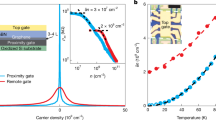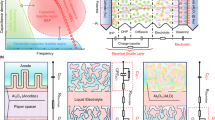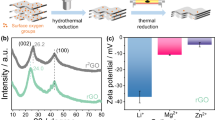Abstract
The classical picture of the force on a capacitor assumes a large density of electronic states, such that the electrochemical potential of charges added to the capacitor is given by the external electrostatic potential and the capacitance is determined purely by geometry1. Here we consider capacitively driven motion of a nano-mechanical resonator with a low density of states, in which these assumptions can break down2,3,4,5. We find three leading-order corrections to the classical picture: the first of which is a modulation in the static force due to variation in the internal chemical potential; the second and third are changes in the static force and dynamic spring constant due to the rate of change of chemical potential, expressed as the quantum (density of states) capacitance6,7. As a demonstration, we study capacitively driven graphene mechanical resonators, where the chemical potential is modulated independently of the gate voltage using an applied magnetic field to manipulate the energy of electrons residing in discrete Landau levels8,9,10. In these devices, we observe large periodic frequency shifts consistent with the three corrections to the classical picture. In devices with extremely low strain and disorder, the first correction term dominates and the resonant frequency closely follows the chemical potential. The theoretical model fits the data with only one adjustable parameter representing disorder-broadening of the Landau levels. The underlying electromechanical coupling mechanism is not limited by the particular choice of material, geometry, or mechanism for variation in the chemical potential, and can thus be extended to other low-dimensional systems.
This is a preview of subscription content, access via your institution
Access options
Subscribe to this journal
Receive 12 print issues and online access
$259.00 per year
only $21.58 per issue
Buy this article
- Purchase on SpringerLink
- Instant access to full article PDF
Prices may be subject to local taxes which are calculated during checkout




Similar content being viewed by others
Change history
25 February 2016
In the version of this Letter originally published, dashed lines indicating where the model is not expected to be accurate were omitted from the lower two panels in Fig. 4a. This has been corrected in all versions of the Letter.
References
Feynman, R. P., Leighton, R. B. & Sands, M. The Feynman Lectures on Physics Vol. 2 (Basic Books, 2013).
Eisenstein, J. P. et al. Density of states and de Haas–van Alphen effect in two-dimensional electron systems. Phys. Rev. Lett. 55, 875–878 (1985).
Steele, G. A. et al. Strong coupling between single-electron tunneling and nanomechanical motion. Science 325, 1103–1107 (2009).
Lassagne, B., Tarakanov, Y., Kinaret, J., Garcia-Sanchez, D. & Bachtold, A. Coupling mechanics to charge transport in carbon nanotube mechanical resonators. Science 325, 1107–1110 (2009).
Singh, V. et al. Coupling between quantum Hall state and electromechanics in suspended graphene resonator. Appl. Phys. Lett. 100, 233103 (2012).
Ilani, S., Donev, L. A., Kindermann, M. & McEuen, P. L. Measurement of the quantum capacitance of interacting electrons in carbon nanotubes. Nature Phys. 2, 687–691 (2006).
Xia, J., Chen, F., Li, J. & Tao, N. Measurement of the quantum capacitance of graphene. Nature Nanotech. 4, 505–509 (2009).
Zhang, Y. B., Tan, Y. W., Stormer, H. L. & Kim, P. Experimental observation of the quantum Hall effect and Berry’s phase in graphene. Nature 438, 201–204 (2005).
Novoselov, K. S. et al. Two-dimensional gas of massless Dirac fermions in graphene. Nature 438, 197–200 (2005).
Castro Neto, A. H., Guinea, F., Peres, N. M. R., Novoselov, K. S. & Geim, A. K. The electronic properties of graphene. Rev. Mod. Phys. 81, 109–162 (2009).
Klitzing, K. v., Dorda, G. & Pepper, M. New method for high-accuracy determination of the fine-structure constant based on quantized Hall resistance. Phys. Rev. Lett. 45, 494–497 (1980).
Fulton, T. A. & Dolan, G. J. Observation of single-electron charging effects in small tunnel junctions. Phys. Rev. Lett. 59, 109–112 (1987).
Luryi, S. Quantum capacitance devices. Appl. Phys. Lett. 52, 501–503 (1988).
Park, J. et al. Coulomb blockade and the Kondo effect in single-atom transistors. Nature 417, 722–725 (2002).
Lifshitz, R. & Cross, M. C. in Reviews of Nonlinear Dynamics and Complexity (ed. Schuster, H. G.) Vol. 1, 1–52 (Wiley-VCH, 2009).
Bunch, J. S. et al. Electromechanical resonators from graphene sheets. Science 315, 490–493 (2007).
Chen, C. et al. Performance of monolayer graphene nanomechanical resonators with electrical readout. Nature Nanotech. 4, 861–867 (2009).
Zhitenev, N. B. et al. Imaging of localized electronic states in the quantum Hall regime. Nature 404, 473–476 (2000).
Feldman, B. E., Krauss, B., Smet, J. H. & Yacoby, A. Unconventional sequence of fractional quantum Hall states in suspended graphene. Science 337, 1196–1199 (2012).
Koshino, M. & Ando, T. Diamagnetism in disordered graphene. Phys. Rev. B 75, 235333 (2007).
Xu, Y. et al. Radio frequency electrical transduction of graphene mechanical resonators. Appl. Phys. Lett. 97, 243111 (2010).
Moser, J., Barreiro, A. & Bachtold, A. Current-induced cleaning of graphene. Appl. Phys. Lett. 91, 163513 (2007).
Bolotin, K. et al. Ultrahigh electron mobility in suspended graphene. Solid State Commun. 146, 351–355 (2008).
Chen, C. Graphene NanoElectroMechanical Resonators and Oscillators PhD thesis, Univ. Columbia (2013).
Singh, V. et al. Probing thermal expansion of graphene and modal dispersion at low-temperature using graphene nanoelectromechanical systems resonators. Nanotechnology 21, 165204 (2010).
Martin, J. et al. The nature of localization in graphene under quantum Hall conditions. Nature Phys. 5, 669–674 (2009).
Yu, G. et al. Interaction phenomena in graphene seen through quantum capacitance. Proc. Natl Acad. Sci. USA 110, 3282–3286 (2013).
Efros, A. Density of states of 2d electron gas and width of the plateau of IQHE. Solid State Commun. 65, 1281–1284 (1988).
Kravchenko, S. V., Rinberg, D. A., Semenchinsky, S. G. & Pudalov, V. M. Evidence for the influence of electron–electron interaction on the chemical potential of the two-dimensional electron gas. Phys. Rev. B 42, 3741–3744 (1990).
Bolotin, K. I., Ghahari, F., Shulman, M. D., Stormer, H. L. & Kim, P. Observation of the fractional quantum Hall effect in graphene. Nature 462, 196–199 (2009).
Du, X., Skachko, I., Duerr, F., Luican, A. & Andrei, E. Y. Fractional quantum Hall effect and insulating phase of Dirac electrons in graphene. Nature 462, 192–195 (2009).
Dean, C. R. et al. Multicomponent fractional quantum Hall effect in graphene. Nature Phys. 7, 693–696 (2011).
Dean, C. et al. Hofstadter’s butterfly and the fractal quantum Hall effect in moire superlattices. Nature 497, 598–602 (2013).
Ponomarenko, L. et al. Cloning of Dirac fermions in graphene superlattices. Nature 497, 594–597 (2013).
MacDonald, A. H., Oji, H. C. A. & Liu, K. L. Thermodynamic properties of an interacting two-dimensional electron gas in a strong magnetic field. Phys. Rev. B 34, 2681–2689 (1986).
Acknowledgements
The authors thank N. Cooper, I. Aleiner, B. Skinner and G. Steele for helpful discussions; D. Heinz and A. Young for help in building the measurement set-up; N. Clay for fabrication support; K.-C. Fong, T. Heinz, A. Young and A.van der Zande for helpful comments. P.K. and J.H. acknowledge Air Force Office of Scientific Research Grant No. MURI FA955009-1-0705. A.H.M. was supported by the DOE Division of Materials Sciences and Engineering under Grant DE-FG03-02ER45958, and by the Welch Foundation under Grant TBF1473. P.K. acknowledges support from DOE (DE-FG02-05ER46215) for performing experiments and data analysis.
Author information
Authors and Affiliations
Contributions
C.C. and V.V.D. fabricated and characterized the samples, developed the measurement technique and performed the experiments, data analysis and theoretical modelling. M.K. performed disorder-broadened calculations. S.L. and A.G. helped in sample fabrication. A.H.M. provided theoretical support. P.K. and J.H. oversaw the project. C.C., V.V.D., P.K. and J.H. co-wrote the paper. All authors discussed and commented on the manuscript.
Corresponding author
Ethics declarations
Competing interests
The authors declare no competing financial interests.
Supplementary information
Supplementary information
Supplementary information (PDF 1972 kb)
Rights and permissions
About this article
Cite this article
Chen, C., Deshpande, V., Koshino, M. et al. Modulation of mechanical resonance by chemical potential oscillation in graphene. Nature Phys 12, 240–244 (2016). https://doi.org/10.1038/nphys3576
Received:
Accepted:
Published:
Issue date:
DOI: https://doi.org/10.1038/nphys3576
This article is cited by
-
A monolithically sculpted van der Waals nano-opto-electro-mechanical coupler
Light: Science & Applications (2022)
-
Nanomechanical characterization of quantum interference in a topological insulator nanowire
Nature Communications (2019)
-
Unconventional fractional quantum Hall states and Wigner crystallization in suspended Corbino graphene
Nature Communications (2018)
-
Force sensitivity of multilayer graphene optomechanical devices
Nature Communications (2016)



